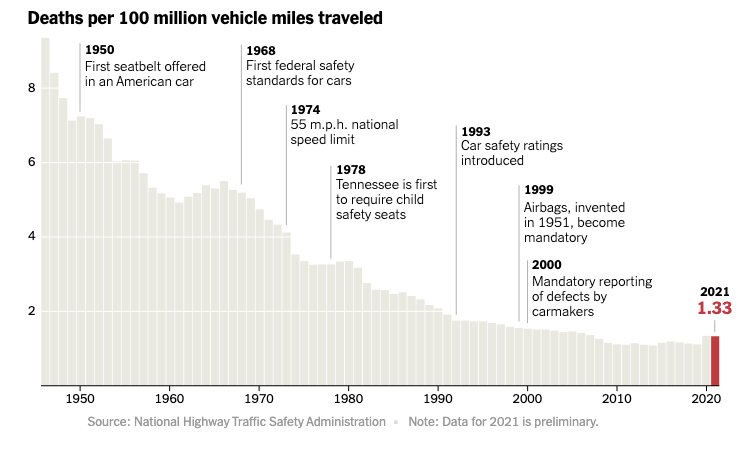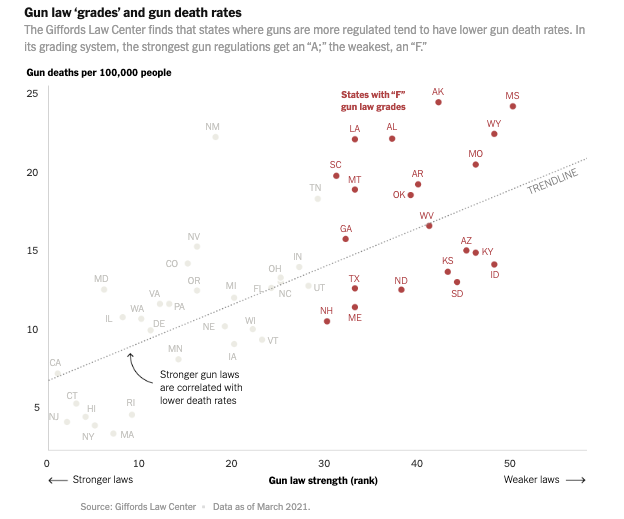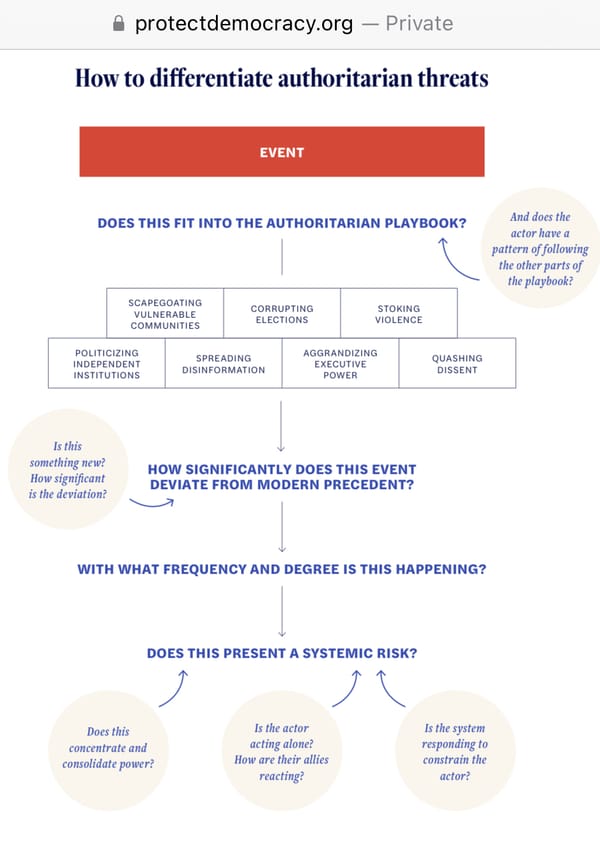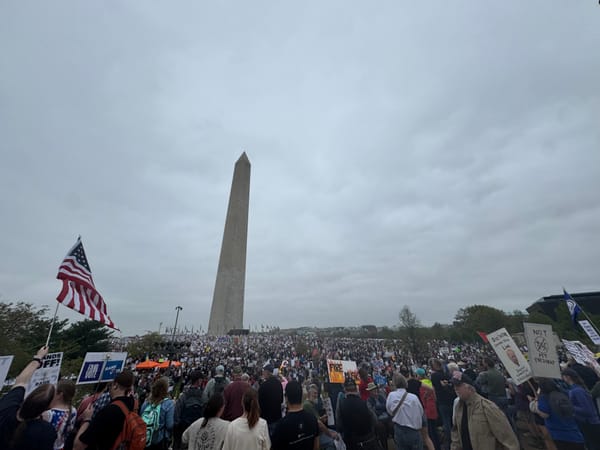Why regulating guns like cars in America would keep more kids alive

As always, thank you for subscribing and amplifying Civic Texts, which will not be sustainable without you. Many thanks to everyone who has supported my work, particularly folks who have subscribed to memberships since our soft launch in April. As always, you can write to me with questions, comments, tips, or other feedback at alex@governing.digital or call/text at 410-849-9808. -Alex
Good afternoon from Washington, where the cool autumn air and golden leaves are starting to fall – and my daughter is back to “asynchronous learning” this Friday after an anonymous threat online yesterday put her school on lockdown, leading to a steady exodus of children all Thursday as worried parents pulled them early.
Today, the Metropolitan Police Department arrested a teenager who had made the threat on social media. What he said online has affected many families offline. The concern this fifteen year-old provoked was quite real, even if the teen didn't possess a firearm when apprehended. All in all, this was not my favorite way to end a week.

I had planned to write about something else today — digging into a milestone in digital government over at the State Department, or yesterday’s Congressional hackathon. I’ll get to both, soon.
But this morning, I was feeling angry and despondent enough to write a bit about guns in the United States.
Last night, I'd watched the family of a teen wounded in a school shooting talk about their experiences with Oprah Winfrey and VP Kamala Harris and thought about being in their place — or that of a family whose child never came home.
It’s unthinkable, and yet every day, parents must think about that possibility in our country.
When there have been hundreds of school shootings since 2018, you can't really avoid thinking about whether your kids will come home in the United States.
You can live in a state of denial, I suppose, but this is the only place in the world where that happens regularly.
No other nation has a category of "toddler-involved shootings." While CDC data show the "overall rate of unintentional shooting deaths of both children and adults has fallen since the 1990s," as Suzy Khimm reported in March 2024, "firearms remain a leading cause of accidental child death."
Those accidents are preventable. So, too, are the homicides.
Let me explain how I think about it.
As a parent, I factor in many other risks daily in 2024, both for the people under my care, other members of my community, and for myself.
I believe in managing risk instead of withdrawing from necessary activities or recreation I enjoy. That's why I wear a helmet when I cycle, buckle a seatbelt when I drive, pull on gloves when I handle pathogens or wild animals, goggles when cut wood and metal, slather on sunscreen on the beach, don a life jacket when a kayak, or wear a respirator when I need to avoid infection from an airborne disease, and so on. I view these interventions, which can range from inconvenient to uncomfortable, as common sense. The fact that I have the right stuff to do [X] safely is proof that I've internalized the scouting mantra of "being prepared." "Semper paratus," as the Coast Guard aptly puts it.
I know the risks of serious injury, illness, or death will go way up if I don’t make informed choices, like swimming above stingrays, or running a generator indoors.
That also why I get vaccinated to reduce the risk of illness or death from a preventable disease, and wash my hands in bathrooms.
Doing this sort of thing is not rocket science: it's an application of germ theory, expressed in basic hygiene that kids should be taught in elementary school.

That’s why it’s so painful to continue to see the delta between how states across the union United States have reduced the risk of fatalities in motor vehicles over the past century through safer cars and stricter regulation — and how we've failed to effectively respond to the risk of fatalities from gun violence, particularly as mass shootings have grown.
In recent years, we’ve continued to see a reduction in motor vehicle deaths in humans aged 1-19 in the United States, while deaths from firearms have risen, as the following graphic from the U.S. Surgeon General traces. Sadly, in 2022, gun violence became the leading cause of deaths of humans aged 1-19, surpassing the car accidents that reckless, inexperienced teen drivers are known for racking up.

As USA Today reported in January, fatal crash statistics show the risk of dying in a motor vehicle accident has dramatically fallen in the USA over the last century, by more than 50% since 1937.
They don’t spend much time explaining why this has happened, from Ralph Nader’s seminal book on unsafe motor vehicles to the Senate hearings that followed to states enacting seatbelt laws to the use of car seats to the many design changes in cars that have made them safer to the creation of government regulators to enforce these standards.
What's amazing is that within a relatively short blip in human history, we've actually made a ton of progress reducing preventable deaths.
In 2021, USA Today reported that of an estimated 6 million police-reported vehicle accidents that happen annually the United States, around 40,000 were fatal. That's a 99%+ survival rate.
And yet, car crashes were still the leading cause of death in the United States for people ages 1 to 54. (After age 55, cancer, heart attacks, and strokes become the leading causes of death – though in 2020-2022, COVID was #1.)
~40,000 people still getting killed every year remains a lot – but I don’t support banning cars. (I think the current designs of electric trucks and SUVs are going to kill more people than necessary, but that's a separate concern.)
What I do support is mandatory driver’s education, requiring learner’s permits and hours of practice, states administering driving tests and issuing licenses, DMVs registering and inspecting cars, and health agencies and police departments defining and enforcing healthier norms about substance use and driving.
I also support suspending or outright revoking a driver's license if someone drives recklessly through a school zone at 100 MPH, much kills a kid in a crosswalk.
Errors in judgement, incompetence, mistakes, or mechanical failures behind an accident can all make prosecuting that kind of homicide complicated, as I was reminded during today's "Politics Hour" on WAMU, but prosecutors can and do seek accountability for drunk drivers and reckless endangerment.
More than 40,000 people dying every year from gun violence is a lot, too.
I see no future where guns are banned entirely in the United States. The Supreme Court's legal interpretation of our Second Amendment right to keep and bear arms for self-defense has been extended by decisions like "New York State Rifle & Pistol Association Inc. v. Bruen" means they're here to say.
But states could save the lives of a lot of kids by following the original words of the Constitution and make a "well-regulated militia" much less of an abstraction by focusing on certain categories of firearms, on registration of all firearms, requiring gun safety courses, and then licensing responsible owners.
Handguns, which account for the majority of gun violence, will remain with us forever, unless we enter the few places in American life where carrying remains unacceptable, like the White House, Congress, or courthose.
Hunting rifles and shotguns are the weapons of hunters in the backcountry. WHile reasonable people may differ, I view them and their responsible use as about as American as apple pie and baseball. I'm still not much of a shot, but I have enjoyed shooting and hunting when I've had the opportunity, much as I do fishing and crabbing.
But as a general principle, I don't see why anyone who isn't a member of the military, reserves, law enforcement officer, needs a AR-15, AK-47, or other weapons of war. Machine guns and semi-automatic firearms may make shooting wild hogs much easier, but the downsides of widespread ownership are apparent to people around the world.
Unfortunately, unless we see a much broader cultural shift and political realignment that marginalizes a toxic gun culture rooted in the high levels of violence and fear across the souther states after the Civil War which has since metastasized across our union in the decades since, such a ban is not happening any time soon.
Research shows that the historical prevalence of slavery predicts contemporary gun ownership across America.
American gun-owners, uniquely, view firearms as a means of keeping themselves safe from dangers both physical and psychological. We root this belief in the experience of White Southerners during Reconstruction—a moment when a massive upsurge in the availability of firearms co-occurred with a worldview threat from the emancipation and the political empowerment of Black Southerners. We show that the belief-complex formed in this historical moment shapes contemporary gun culture: The prevalence of slavery in a Southern county (measured in 1860) predicts the frequency of firearms in the present day. This relationship holds above and beyond a number of potential covariates, including contemporary crime rates, police spending, degree of racial segregation and inequality, socioeconomic conditions, and voting patterns in the 2016 Presidential election; and is partially mediated by the frequency of people in the county reporting that they generally do not feel safe. This Southern origin of gun culture may help to explain why we find that worries about safety do not predict county-level gun ownership outside of historically slave-owning counties, and why we find that social connection to historically slaveholding counties predicts county-level gun ownership, even outside of the South.
Given how deeply held these attitudes remain, elected leaders across our union should consider reducing gun violence using a public health approach, as Nick Kristof suggested in 2022.
Just as requiring driver's licenses reduced preventable deaths, gun licensing laws will reduce preventable gun violence.
The differing experiences of the states can inform public policy a great deal here. For instance, as Kristof reported, gun homicides and suicide rates decreased after Connecticut passed a law, and increased after Missouri repealed its law.

Mental health problems are evenly distributed around the world. So are angry young men: hurt, isolated, and radicalized. What makes the outcomes in the USA different is the amount of guns – hundreds of millions of firearms are estimated to be within order borders – and access to them.
We could change that, too. About 9 out of 10 Americans agree people who want to buy a gun should have to pass a universal background check – but about a fifth of all guns are sold in 2022 without one. The House passed a bipartisan bill that year that would have mandated checks that didn't advance.
If enacted in every state, such checks and widespread gun licensing will lead to fewer children murdered in our communities. Texas has weaker gun laws, gun mortality is higher there.

Data show regulating militias well saves lives, if legislators can maintain the courage of their convictions, buck the gun lobby, face down fears about "gun-grabbing."
Gun violence is also a challenge here in the District of Columbia, where I reside. While overall violence continues to drop after spiking in 2020, there may still be over 200 homicides again this year.
What gives? The District is already doing much of what I suggested. DC requires licensing, registration, background checks, and more for Washingtonians who wish to bear firearms. Firearms bought in DC are rarely used in crimes.
And yet, gun violence remains stubbornly high. That's because almost every gun recovered at a crime scene in DC was bought in another state. This is also true in Chicago, where the overwhelming majority of firearms used in a crime are acquired elsewhere. We need a holistic approach across the states that only the federal government can nurture.
No singular change to gun laws in the United States would prevent all mass shootings in a vast nation with hundreds of million of guns, but the evidence across our laboratories of democracy show how we could reduce preventable deaths, while allowing law-abiding citizens to continue to obtain & retain firearms – as we do cars.
I know this isn't new: people have been suggesting that regulating guns like cars could improve public safety for many years. The graphic from Everytown says in a moment what I've spent a couple of thousand words on today. But good ideas can get into law when public health problems like gun violence don't resolve and public anger grows.
If 60 pro-living Senators decided to mandate universal background checks, gun licensing, and registration someday, it would lead to more kids alive and at liberty, pursuing happiness with the families who love them.
I'd like to live in that union.



